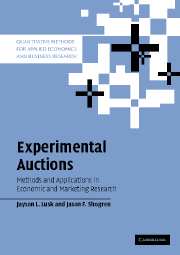Book contents
- Frontmatter
- Contents
- List of figures
- List of tables
- 1 Introduction
- 2 Incentive compatible auctions: theory and evidence
- 3 Value theory
- 4 Conducting experimental auctions: some preliminaries
- 5 Conducting experimental auctions
- 6 Data analysis
- 7 Valuation case studies
- 8 Auction design: case studies
- 9 Validity of experimental auctions
- 10 The future of experimental auctions
- References
- Index
7 - Valuation case studies
Published online by Cambridge University Press: 27 October 2009
- Frontmatter
- Contents
- List of figures
- List of tables
- 1 Introduction
- 2 Incentive compatible auctions: theory and evidence
- 3 Value theory
- 4 Conducting experimental auctions: some preliminaries
- 5 Conducting experimental auctions
- 6 Data analysis
- 7 Valuation case studies
- 8 Auction design: case studies
- 9 Validity of experimental auctions
- 10 The future of experimental auctions
- References
- Index
Summary
Introduction
We now present nine case studies to illustrate experimental auctions at work in practical applications. This chapter presents case studies showing how we have used experimental auction methods to estimate the value of new or non-market goods and how those values are used in welfare analysis and to estimate the success of new products. These case studies are grouped into three broad categories: informing policy, marketing, and valuing controversial goods. In the policy case studies, we consider experimental auctions designed to address a grading system for beef tenderness, behavior toward food safety, and the acceptable tolerance levels for genetically modified food. For the marketing case studies, we present auctions designed to evaluate the market share for branded beef products, value characteristics of pork, and value financial records. The last set of case studies focus on controversial goods, where we estimated demand for genetically modified food, the impact of information on preferences for irradiated foods, and the demand for products of ambiguous quality like fresh meat produced with growth hormones.
Informing Policy I: beef tenderness grading system
Since the 1900s, the United States federal government has set and maintained grades and standards for many agricultural products. In theory, grades and standards improve market efficiency by reducing problems associated with information asymmetry, that is, consumers and producers know the type/quality of the goods they are buying and selling. Federal grading of agricultural products was authorized by the US Congress through the Agricultural Marketing Act of 1946.
- Type
- Chapter
- Information
- Experimental AuctionsMethods and Applications in Economic and Marketing Research, pp. 113 - 195Publisher: Cambridge University PressPrint publication year: 2007



